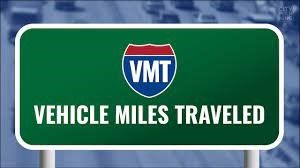What is the Vehicle Miles Traveled Tax and Why Does it Matter?

This is a proposed tax that would charge every U.S. driver for miles driven rather than the amount of fuel that goes into the vehicle. This tax has been proposed in various states in the U.S. as an infrastructure funding mechanism to replace, or supplement the fuel tax, which has been generating billions less in revenue each year due to increasingly fuel-efficient vehicles. This tax could be either a flat fee (like a fixed number of cents per mile), or a variable fee based on considerations such as time of travel, congestion levels on a facility, type of road, type and weight of vehicle, vehicle emission levels, and ability to pay of the owner. This tax could also be a combination of flat and variable fees.
Since 2000, fuel tax revenues have declined significantly as a result of less driving and increasing fuel efficiency. As fuel tax revenues dwindle, policymakers have had to divert billions from the general fund and other non-transportation funds to pay for infrastructure. This is increasing pressure on transportation policy makers to search for new, viable road financing mechanisms. Ultimately though, Congress is responsible for the deficit spending and the lack of sustainable funding for the Highway Trust Fund, not truck drivers.
The American Transportation Research Institute (ATRI) determined that replacing the federal fuel tax with a VMT tax that is assessed on 272 million private vehicles could result in collection costs of more than $20 billion annually – 300 times higher than the federal fuel tax. The main reason for this large increase in costs is the shift in collection points – from a couple of hundred fuel terminal operators to every registered motor vehicle in the U.S. Beyond providing a more stable revenue stream, VMT fees could support many other goals. Rates could be structured to help reduce congestion and harmful emissions, metering devices could provide value-added services (e.g., safety alerts, real-time traffic information and routing assistance, and the ability to save money with pay-as-you-drive insurance), and the system could generate rich travel data for improved transportation planning.
How Would VMT Fees be Implemented?
The application of VMT fees is envisioned as using an onboard vehicle device to capture the distance driven through GPS or other technology and relate that to a method of charging. This could involve payments at the gas pump, billing, or automatic deductions for a prepaid customer account. GPS units on board a vehicle can record distance, assign it to the appropriate taxing jurisdiction, and calculate the amount owed.
How Much Would You Pay Under a VMT Tax?
Last year, the House passed a bill that would have created a federal pilot program to test a vehicle miles-traveled (VMT) tax. Under the legislation, the Treasury Department would impose a fee equal to the total amount collected in gas taxes, divided by the miles driven by passenger vehicles. The figure works out to about nine-tenths of a cent per mile, using data from 2019, the most recent available.
If you drive 12,000 miles in a year, and your car gets 22 miles per gallon … you would pay $5.24 more under a VMT tax –
VMT Tax – 12,000 Miles X $.0088 = $105.60
Gas Tax – 545 Gallons x $.18 = $100.36
Difference = $5.24
Taxing mileage has one big advantage over taxing gas in that it captures electric vehicles. It has one big disadvantage in that it reduces the incentive to buy electric or fuel-efficient vehicles.
What are the Challenges Facing the VMT Tax Program?
The VMT tax is a far more complicated and costly replacement for the fuel tax than many had anticipated. A report found that hardware costs alone associated with the VMT tax would have an initial price tag of $13.6 billion and require ongoing replacement, telecommunications costs would be about $13 billion annually and account administration would be an additional $4.3 billion each year. Many years of planning and federal leadership would be needed to make a system like this work for everyone.
Another major challenge would be compliance. The federal system would likely have to rely on state or local enforcement agencies to prevent significant evasion. Some sort of compliance monitoring system would be needed to prevent evasion. The VMT also raises tough privacy questions about the government tracking the travel of motorists.
Further, ATRI said, without the ability to ensure mandatory participation in the VMT and methods in place to collect delinquent payments, incidents of VMT tax evasion are likely to be high.
Current VMT Programs in the U.S?
The state of Oregon currently has a program that began in 2015 which has been relatively successful called OReGO. About 1,800 drivers have gone through it and 700 are enrolled today. The program allows drivers to opt for paying the state fuel tax or VMT taxes. The drivers are assured that their privacy will be protected by anonymizing driver data. Drivers there who choose the VMT tax get a credit for the amount of gas tax they pay and their cars keep track of miles driven and gas consumed via a special diagnostic device that’s easy to install.
Developing an equitable and effective VMT tax will be no small feat. The future of funding for America’s highways will be the topic of much political discussion for some time to come.

Sources:
“The High-Priced Reality of a National Vehicle Miles Traveled Tax”, FleetOwner Staff, March 18, 2021.
“Two States Tax Some Drivers by the Mile – Many More Want to Give it a Try”, Ian Duncan, The Washington Post, March 12, 2021.
“Moving Toward Vehicle Miles of Travel Fees to Replace Fuel Taxes – Assessing the Path Forward”, Rand Corporation, Lisa Ecola, Paul Sorenson, Martin Wachs, Max Donath, Lee Munnich and Betty Serian.


